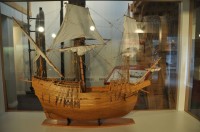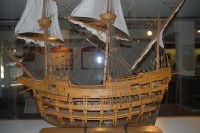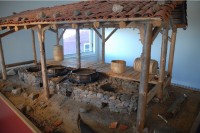 A team of Spanish maritime historians will build a full-size, seaworthy replica of the San Juan, a Basque whaling galleon that sank near the shore of Red Bay, Labrador, in the autumn of 1565. The wreck of the 52-foot, three-masted, 250-ton ship was discovered in 1978 by Parks Canada divers working on clues unearthed in documents found in Valladolid and Oñate by federal archivist Selma Huxley Barkham. It’s the oldest shipwreck ever discovered in Canadian waters and an invaluable source of information about Basque shipping in general and the Basque presence in Canada in particular.
A team of Spanish maritime historians will build a full-size, seaworthy replica of the San Juan, a Basque whaling galleon that sank near the shore of Red Bay, Labrador, in the autumn of 1565. The wreck of the 52-foot, three-masted, 250-ton ship was discovered in 1978 by Parks Canada divers working on clues unearthed in documents found in Valladolid and Oñate by federal archivist Selma Huxley Barkham. It’s the oldest shipwreck ever discovered in Canadian waters and an invaluable source of information about Basque shipping in general and the Basque presence in Canada in particular.
Canadian archaeologists will meet with Spanish experts this week to share all the information on the ship’s construction they’ve accumulated over the decades.
“Right from the start, we thought this was a really, really great idea,” said Marc-André Bernier, Parks Canada’s chief of underwater archeology. “For archeologists, this is basically the ultimate final product. You’re taking all of the research from a site that’s been excavated, then you take it to the maximum in experimental archeology,” physically recreating “what is lost.”
 The replica will take several years to build. It’s scheduled to be up and running by 2016 in time to be a part of the celebrations in the Basque city of San Sebastian which has been designated by the Europe Council of the European Union as a European Capital of Culture for 2016. San Sebastian is on the southern coast of the Bay of Biscay and was an important capital of shipping during the Middle Ages and Age of Discovery. Many of the whaling expeditions to Labrador (known as the Carrera de Terranova or Newfoundland Run) in the 16th century departed from San Sebastian and were funded by its financiers.
The replica will take several years to build. It’s scheduled to be up and running by 2016 in time to be a part of the celebrations in the Basque city of San Sebastian which has been designated by the Europe Council of the European Union as a European Capital of Culture for 2016. San Sebastian is on the southern coast of the Bay of Biscay and was an important capital of shipping during the Middle Ages and Age of Discovery. Many of the whaling expeditions to Labrador (known as the Carrera de Terranova or Newfoundland Run) in the 16th century departed from San Sebastian and were funded by its financiers.
The Terranovan whaling voyages were as profitable as the Carrera de Indias (Indies Run) which transported massive quantities of gold and silver to Spain. The earliest Spanish records on Labrador whaling date to the 1540s and they document extensive trade in “lumera” (whale oil used for lamps which burned brighter than vegetable oils), and blubber that was used in the construction of ships, the manufacture of soap, pharmaceutical products and in the textile industry. The Basque shipping industry had extensive experience in whaling closer to home, so when the new market opened in the New World, their expertise ensured big profits from day one. Even during war between France and Spain and outbreaks of piracy in the 1550s, Basque ships carried whale products to England, Flanders and Spain.
An average of 15 Basque ships a year did the Labrador-Europe run, each of them carrying at least 1,000 400-pound barrels of whale oil and blubber. That’s a conservative estimate. Many years production exceeded 15,000 barrels per year. The number of whales killed in the Strait of Belle Isle averaged 20 per ship. The San Juan was carrying almost 1,000 barrels of whale oil when she went down. Most of that was salvaged from the wreck and sent to its destination.
 Although Basque whalers were a major presence in the Labrador straits from the 1530s to the early 17th century, they haven’t gotten much attention because they didn’t put down roots. Their interest in Canada was purely commercial; there was no attempt to colonize it. They summered on the coast, building camps and red-tiled huts over cauldron furnaces which boiled for days, rendering the whale blubber. Those curved red tiles are highly distinctive, a characteristic element of Basque architecture and one of the few pieces of physical evidence the Basque crews left behind. They were also used to roof the cooperage cabins in which all those thousands of barrels needed to transport the whale oil were made.
Although Basque whalers were a major presence in the Labrador straits from the 1530s to the early 17th century, they haven’t gotten much attention because they didn’t put down roots. Their interest in Canada was purely commercial; there was no attempt to colonize it. They summered on the coast, building camps and red-tiled huts over cauldron furnaces which boiled for days, rendering the whale blubber. Those curved red tiles are highly distinctive, a characteristic element of Basque architecture and one of the few pieces of physical evidence the Basque crews left behind. They were also used to roof the cooperage cabins in which all those thousands of barrels needed to transport the whale oil were made.
 One of the most exceptional Basque artifacts ever recovered in Labrador’s Red Bay was a nearly complete whaling rowboat known as a chalupa. Sounds delicious, I know, but it’s actually a small vessel used to chase, harpoon and tow whales. It was found pinned beneath the collapsed side of a 200-ton whaling ship and was excavated and re-assembled board by board. It’s now on display at the Red Bay National Historic Site visitor’s center, along with reconstructions of the red-tiled rendering cauldron huts, models of the San Juan and a replica of a section of a whaling hull that shows how the barrels were packed.
One of the most exceptional Basque artifacts ever recovered in Labrador’s Red Bay was a nearly complete whaling rowboat known as a chalupa. Sounds delicious, I know, but it’s actually a small vessel used to chase, harpoon and tow whales. It was found pinned beneath the collapsed side of a 200-ton whaling ship and was excavated and re-assembled board by board. It’s now on display at the Red Bay National Historic Site visitor’s center, along with reconstructions of the red-tiled rendering cauldron huts, models of the San Juan and a replica of a section of a whaling hull that shows how the barrels were packed.
In Portugal and Galicia one of the national ingredients is bacalhau or dried cod. It is probably the only produce from the sea that they don’t eat fresh and there are loads of different recipes. And this is all because of the basques going to Newfoundland to hunt whales!
cool beans !
Yes! I can’t get enough of ship replicas.